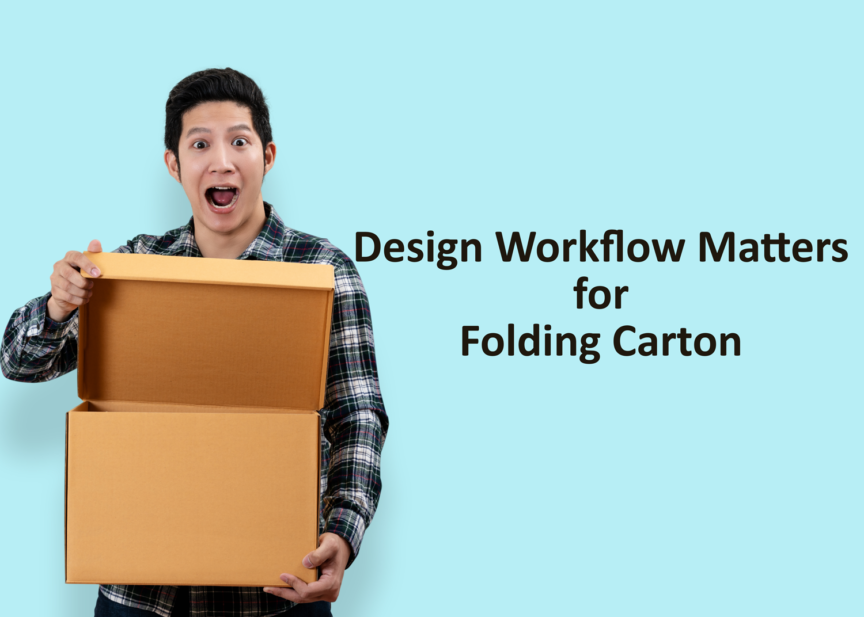How can you avoid a good-looking folding carton? Bright colors and design make a promise that what is inside will excite and intrigue. It’s what has made unboxing a category on YouTube, Facebook, and Instagram. People love to share the excitement of opening the box to see how the promise delivers.
The journey to an intriguing box begins with the design. That design may be determined by the owner of the product that will go into the box or by a group of people who work for the brand/product, designers from their design agencies with some influence from the pre-media houses they work with. For example, the product owner may have a vision of a box that opens from the top-center and reveals text and graphics on the interior that coordinate with the design on the exterior. They may be thinking of bright colors, bold text, and variable content based on the target markets. Sounds great!
The vision gets passed to the design team, and things begin to change. The discussion turns to how the box will lay flat, and how it will come together. Will there be glue lines? Where will the creases and folds be located, and how will the box look when it is opened and when it is closed. Is this a box design that has been used before, so the dielines are known, or is this new box design? How much will it cost to produce? Will it need to be post-coated?
Lots of questions, but the result brings clarity to how to brief the graphic designer. The specification explains the size, where the unprintable areas are, and where the joins are located for corners, the sides, the top, and the bottom. The team will not want to create a box where the logo is bifurcated by a fold or the product image disappears into a tuck!
Those are the technical concerns, but let’s talk about the art file. A PDF file is the lingua franca for most printing today. Creating a PDF is easy! Products from Adobe Creative Cloud, Autodesk, ESKO, Kasemake, and a large stable of design products dedicated to packaging are available at a variety of price points. Most designers have their favorite tools and understand how to use them to achieve the color profile they need to meet the product owner’s goals. But, as much as designers know their tools, they may not be creating the best PDF files.
The definition of what makes a best PDF file may vary by application, but for folding carton applications, the best file is clean, flat, and free of extraneous structures. Most designers are sure that this is what they are doing, but if you ask the pre-media services and prepress teams that work with their files you hear a different story.
Here are a couple of common mistakes!
- Image resolution that is mismatched to the target output device.
The story here is that designers should ask what the target output device is for their folding carton design. It may be traditional analog printing where the PDF is rendered to a plate for flexo printing, or it may be a digital device. Not all digital devices are created equally. They have preferred specifications for the resolution of image assets, which could vary based on the stock, type of ink, priming and post-coating. Ask what is expected and work to that resolution, without stretching or shrinking. - Don’t just Crop – Trim!
If you take the time to read the Global Graphics book Full Speed Ahead, Second Edition, you learn that there is a bit of magic in PDF. It retains information, sometimes information you think is gone! An example is the result of what happens when you crop an image in your design file. Cropping alters the visible appearance of the image, but the area cropped from the image is still in the file, hidden. That means the RIP must work to identify what part of the image should be rendered and what part should be hidden. That takes processing, and processing is time. The solution is to trim away what you don’t want so that the image is only what you will use.
From a design perspective, you might want to crop first to ensure you have what you want, and then only do the trim once you are certain you are ready to create your print-ready file. Why? Once you trim the image, those pixels are gone. During the design process you may be moving images and changing orientations. Wait until you have done that work, and then do the trim.
Inkjet brings many options for folding carton production, but take the time to ensure that you don’t create bottlenecks in the workflow with overweight PDF files!
If you’ve created a workflow that you’d like to share, let’s have a chat! Remember, there are a million questions in inkjet city! Have questions? Get in touch.

